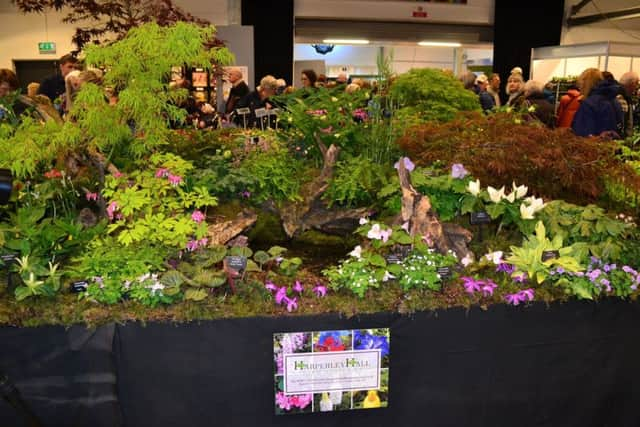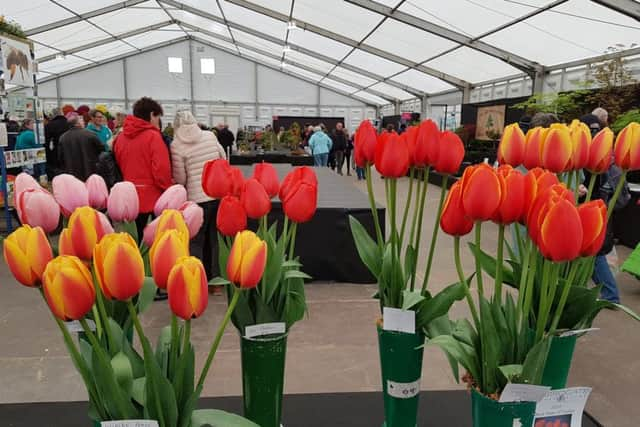Grab some horticultural bargains at annual Harrogate Spring Flower Show


Running from Thursday, April 25, to Sunday, April 28, there’s a real spirit of friendliness, terrific plants plus the chance to grab some great horticultural bargains.
Staged at the Great Yorkshire Showground, the event attracts up to 60,000 visitors and around 1,000 exhibitors.


Here are just some this year’s highlights:
Advertisement
Hide AdAdvertisement
Hide AdThe theme is #kerbcouture, with mural artist Lee Ferry, from County Durham, transforming the bleakest of back streets with garden graffiti, exploring how the urban environment could be revolutionised by the use of plants.
#kerbcouture will feature a street of bloom-bombed buildings and pavements, plus a range of small-scale show gardens challenging designers to think vertically in The Blank Wall Project or make every inch count with Square Yards.
There’s also a host of show gardens that offer ideas easily translatable to ordinary plots, unlike the bigger RHS shows!


The Plant Nursery Pavilion hosts dozens of displays by the UK’s top nurseries, one of the features that helped to make the spring show Britain’s best gardening event for readers of Which? Gardening.
Advertisement
Hide AdAdvertisement
Hide AdExhibitors offer unrivalled knowledge and rare plants at cut-price show rates.
Britain’s biggest and best exhibition of flower arranging and floristry takes place at the spring show, with more than 150 works of art and many large-scale arrangements in the Floral Pavilion.
Look forward to a selection of seasonal dishes from a line up of talented chefs and join experts and watch your gardening knowledge GROW!
The show hosts more than 100 garden-related exhibitors with thousands of products.
Advertisement
Hide AdAdvertisement
Hide AdThere is a secure creche for plants and products, so you don’t have to carry them around.
Craft-wise, there are more than 70 exhibitors and a Made in Yorkshire marquee, plus lots of artisan food and drink to bring home.
For the children, Pod is back as he creates a ‘garden in the sky’ and young gardeners can create some fantastic hanging pots at Pod’s pop-up play patch.
Fill it with plants provided by Askham Bryan College.
Tickets cost £19 Thursday to Saturday and £17 for Sunday, when bought before Tuesday, April 16; £21.50 and £19.50 on the gate. Under 16s go free and parking is free.
Advertisement
Hide AdAdvertisement
Hide AdGo online at www.flowershow.org.uk for further details on the show and tickets information.
GET IN TOUCH
l For more information, plus cook what you grow, recipes, environmental news and more, log on to the website at www.mandycanudigit.com – which is also now smartphone friendly.
You can also follow Mandy on social media platforms – on Twitter @MandyCanUDigIt or you can like her on her Facebook page at Mandycanudigit
JOBS TO DO THIS WEEKEND
There are lots of annuals you can sow now including Californian poppy, Nigella and poached egg plants, which are good for pollinators.
Advertisement
Hide AdAdvertisement
Hide AdSupport peas sown last autumn or earlier this year, using twiggy sticks, or wide mesh netting. Prepare runner and climbing French bean supports if you want to save time later in the year.
Deadhead daffodils, but let the leaves die down naturally, to store food for next season’s display.
Tie in honeysuckle, clematis and other climbers as new growth starts to sprout.
On variegated plants, prune out shoots that have reverted to green. If left unchecked, they will eventually take over from the variegation.
Advertisement
Hide AdAdvertisement
Hide AdPerennials should be staked early so they can be tied in unobtrusively before they start to flop. Use prunings from around the garden to make your own supports.
Feed the soil if your winter has been excessively wet. Use homemade garden compost, or well-rotted manure, around established plants, and in planting holes for new plants.
Tear off rose suckers. Cutting leaves a growth bud but tearing rips it off.
To prevent algae build-up in your pond, add a small bale of barley straw, available from most garden centres, at £6-£7. As light levels and temperatures increase, this triggers algae growth in the pond, making the clear water go green. Have plenty of plants around the pond’s sides for moist shelter, essential if your pond is set in gravel.
Advertisement
Hide AdAdvertisement
Hide AdDivide clumps of herbs that have become too large. Plants, such as bay, that are difficult to propagate otherwise, can be layered now. Refresh herbs growing in pots by scraping off the top 5cm/2” of compost, topping up with fresh and finishing off with a layer of horticultural grit to retain moisture.